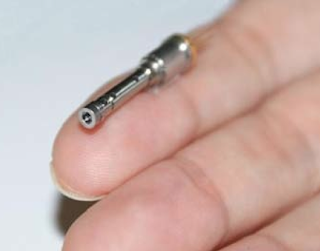Get this; a company (spun-off from Fujitsu) has successfully made a green emitting laser using Quantum Dots. The company, called QD Laser, Inc. (how original) created a quantum dot semiconductor crystal that emits at 1064nm. A quick frequency doubling yields the 532nm laser line we all know and love. Now, they certainly aren't making this for the biomedical research crowd, but hey none of the tech we use today was developed for flow cytometry. It's the trickle down effect that gives us all the great gems. So, you're probably saying, who cares, a 532nm laser, we have a ton of them. Well, besides this being made from a Qdot, it also is super low-power consuming, and it is tiny; see the pic below. QD Laser envisions these lasers along with already available red and blue lasers as the projection source of an RGB miniature projector that can be embedded in smartphones. However, I'm envisioning these lasers on my handheld cytometer.
A Blog about the world of Image and Flow Cytometry. Coming to you from the core facility at the University of Chicago
Saturday, May 22, 2010
Wednesday, May 19, 2010
HyperCyt Demo 5/25, 5/26
We will be demonstrating a new 96/384 well sampler on the LSRII-Orange next week. To introduce the platform, we will host a seminar on Tuesday, 5/25 at 10AM in Cummings Room 119. On Wednesday the 26th, we are looking for people who wish to try out the sampler using their own samples. Since this unit will be installed on our LSRII-Orange, please be aware of the lasers/filters on that specific instrument. Here's a few stats on this system. More info can be found on their web site @: http://intellicyt.com/products_hypercyt.php
-Max speed: Full 96 well plate in 2.5 minutes, Full 384 well plate in 10 minutes
-Sample Volume: as little as 2ul with zero dead volume, and as much as a full well
-Can be connected to a variety of cytometers
-Carryover in High Throughput Mode can be 1-2%, but inter-well washes decreases carryover to less than 1%
If anyone else out there has one of these, I'd be interested in your thoughts as well. We've used the BD HTS system on a FACSCalibur with not-so-great results, so are looking for something more high throughput, and more stable.
-Max speed: Full 96 well plate in 2.5 minutes, Full 384 well plate in 10 minutes
-Sample Volume: as little as 2ul with zero dead volume, and as much as a full well
-Can be connected to a variety of cytometers
-Carryover in High Throughput Mode can be 1-2%, but inter-well washes decreases carryover to less than 1%
If anyone else out there has one of these, I'd be interested in your thoughts as well. We've used the BD HTS system on a FACSCalibur with not-so-great results, so are looking for something more high throughput, and more stable.
Tuesday, May 11, 2010
CYTO 2010
Here in Seattle at the CYTO 2010 meeting (the new branding of ISAC, for those unaware). It has been a very typical ISAC, content-wise, but a huge success, location-wise. Seattle has turned out to be a pretty ideal site for one of these meetings. We're having the meeting at the Washington State Trade and Convention Center in downtown Seattle. Being from Chicago, it sort of feels like home, but really, really condensed into about a 10-block radius. Literally, everything you need is in walking distance. So, Seattle definitely gets a thumbs-up from me.
As far as the meeting content, the 'hot' technology is definitely the CyTOF from DVS Sciences. We first saw this instrument at last year's GLIIFCA meeting, but there are now many good examples of the technology in the field...and it looks really nice. As you can probably gather from the name, it's a mass spec instrument that is being used to analyze cells. How? Pretty simply: you basically take traditional antibodies, and instead of coupling them to fluors, like FITC and PE, you couple them to mass spec-type stable isotopes. Then you load your 'stained' sample into the CyTOF, and ituses a laser to basically vaporizes and ionizes the compound in an Inductively Coupled Plasma (ICP-Mass Spec, not Maldi-Tof Mass Spec) yielding a specific signature. Since there are around 100 isotopes available for these types of applications, AND, the resolution between isotope detection, you can basically do a 50 'color' experiment without compensation. So, now, you can do huge multiplexed assays with really, really, good resolution. There are even examples of doing a luminex type assay on this. If you load the beads with a few different combinations of different isotopes, you can easily create a 1,000,000 plex luminex assay! I see an S-10 application in my future!
I'll update with more info again soon, including info about our posters!
As far as the meeting content, the 'hot' technology is definitely the CyTOF from DVS Sciences. We first saw this instrument at last year's GLIIFCA meeting, but there are now many good examples of the technology in the field...and it looks really nice. As you can probably gather from the name, it's a mass spec instrument that is being used to analyze cells. How? Pretty simply: you basically take traditional antibodies, and instead of coupling them to fluors, like FITC and PE, you couple them to mass spec-type stable isotopes. Then you load your 'stained' sample into the CyTOF, and it
I'll update with more info again soon, including info about our posters!
Subscribe to:
Comments (Atom)
